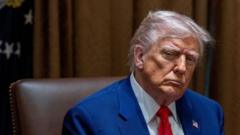Former President Donald Trump's recent announcement of a sweeping tariff plan sparked intense global debate, but now a significant portion of that plan is momentarily halted as he has suspended imposing higher tariffs for the next 90 days. This pause comes amid a tightening trade conflict with China and has prompted questions about whether Trump is edging closer to realizing his ambitious trade goals. Here, we closely examine five primary objectives Trump set forth and their current status.
1) Securing Better Trade Deals
Trump criticized the long-standing trade practices that he believes have harmed American interests, stating that 'America has been looted.' His strategy initiated universal tariffs coupled with specific levies on countries deemed the worst offenders. In response, numerous nations have reportedly reached out to negotiate with Trump, with Treasury Secretary Scott Bessent noting contact from over 75 world leaders. However, it remains to be seen whether these ongoing discussions will yield meaningful trade agreements before the deadline approaches.
2) Stimulating American Industry
The former president claimed tariffs would rejuvenate the American manufacturing sector and lead to job creation. However, the volatility of his tariff policies creates instability, making it less likely for businesses to commit to relocating production or investing in new facilities. Without consistent tariff levels and predictability, firms might opt to hold off on substantial investments until clarity emerges in the policy landscape.
3) Confronting China
Trump has long viewed China as the primary adversary in America's trade disputes. Notably, his recent tariff adjustments suggest a desire to escalate his confrontation with this major economy. However, the danger lies in the fact that provoking China could drive a wedge between the U.S. and its allies, making it difficult to rally necessary support against a common economic challenge.
4) Enhancing Revenue Streams
During his presidency, Trump often asserted that tariffs would generate significant new revenue, which could be used to address the national debt and fund governmental initiatives. Economic research has indicated that a 10% tariff could potentially yield trillions of dollars over a decade. If Trump maintains his current tariff structure, he could see some revenue come in, although many experts warn this could be offset by shifts towards domestic production.
5) Lowering Consumer Prices
Lastly, Trump has promised that increased domestic production through tariffs would eventually lower costs for U.S. consumers. However, many economists predict that tariffs are more likely to raise prices for consumers, as costs are passed down from manufacturers. A previous analysis projected that a 10% tariff could increase household expenses by over a thousand dollars in its first year, posing significant challenges for lower-income families.
As Trump navigates this complex economic landscape, the outcomes of these tariff initiatives remain in flux. The looming uncertainty threatens not only his political capital but also poses risks to broader economic stability in the United States and beyond.






















